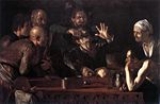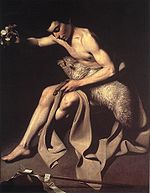
Paintings attributed to Caravaggio
Encyclopedia
A number of paintings have been attributed from time to time to the Italian
artist Michelangelo Merisi da Caravaggio
(1571–1610), but are no longer generally accepted as genuine. Immensely popular in his own lifetime, he fell into neglect almost immediately upon his death, with the result that now, four hundred years later, it's often extremely difficult to distinguish works by the master from copies or from original creations by his most gifted followers.
 The case in favour of recognising The Tooth Puller as was first advanced by the scholar Mina Gregori in 1992, and John Gash discussed the case in an article in Melita Historica in 1998. On the side of arguments for genuineness, almost every figure in the painting is based on figures in other, genuine, works by Caravaggio, and from such a variety of sources and cities that it's almost inconceivable that any Caravaggisti could have seen them all; the style is typical of Caravaggio's late style, specifically his Maltese stay in 1607/1608; and he had begun his career in Rome with broadly similar genre works. On the other hand, there is no other surviving example of a genre painting by Caravaggio after about 1600, and, of course, there is no mention of the painting - or of any late-period genre painting - in sources such as Giovanni Bellori, who otherwise seems to have been thorough in seeking out Caravaggio's works.[.
The case in favour of recognising The Tooth Puller as was first advanced by the scholar Mina Gregori in 1992, and John Gash discussed the case in an article in Melita Historica in 1998. On the side of arguments for genuineness, almost every figure in the painting is based on figures in other, genuine, works by Caravaggio, and from such a variety of sources and cities that it's almost inconceivable that any Caravaggisti could have seen them all; the style is typical of Caravaggio's late style, specifically his Maltese stay in 1607/1608; and he had begun his career in Rome with broadly similar genre works. On the other hand, there is no other surviving example of a genre painting by Caravaggio after about 1600, and, of course, there is no mention of the painting - or of any late-period genre painting - in sources such as Giovanni Bellori, who otherwise seems to have been thorough in seeking out Caravaggio's works.[.
 According to tradition Caravaggio painted flowers and fruit when he first came to Rome. Individual pieces of this Still Life with Flowers and Fruit are brilliantly painted and call to mind the mastery of such subjects that Caravaggio showed in early works such as Boy with a Basket of Fruit
According to tradition Caravaggio painted flowers and fruit when he first came to Rome. Individual pieces of this Still Life with Flowers and Fruit are brilliantly painted and call to mind the mastery of such subjects that Caravaggio showed in early works such as Boy with a Basket of Fruit
, as well as his reported comment that it took as much trouble to paint a flower as it did to paint a man. Nevertheless, the overall composition is awkward and it is not accepted as genuine. The painting is ascribed to an artist known as the Painter of the Wadsworth Atheneum Still-Life, after a work in the Wadsworth Atheneum
, Hartford, Connecticut
.
 The John the Baptist from Basle has many of the stylistic marks of Caravaggio - the use of deep shadows, the isolated youthful Baptist - but is not widely accepted as genuine. A comparison with Carlo Sellitto
The John the Baptist from Basle has many of the stylistic marks of Caravaggio - the use of deep shadows, the isolated youthful Baptist - but is not widely accepted as genuine. A comparison with Carlo Sellitto
shows how well the more gifted of Caravaggio's followers absorbed not only the superficial tricks of style but the underlying ethos as well, to the point of becoming virtually indistinguishable from the work of the master. The Basle Baptist, despite being a very attractive painting in its own right, is a quite forthright and traditional piece of Counter-Reformation iconography (the Baptist is holding out roses, symbol of the Passion, before the sheep, representing Christ's future sacrifice), and has none of the deep pathos and ambiguously mingled sensuality and spirituality that Caravaggio brought to his long contemplation of John the Baptist
.
Italy
Italy , officially the Italian Republic languages]] under the European Charter for Regional or Minority Languages. In each of these, Italy's official name is as follows:;;;;;;;;), is a unitary parliamentary republic in South-Central Europe. To the north it borders France, Switzerland, Austria and...
artist Michelangelo Merisi da Caravaggio
Caravaggio
Michelangelo Merisi da Caravaggio was an Italian artist active in Rome, Naples, Malta, and Sicily between 1593 and 1610. His paintings, which combine a realistic observation of the human state, both physical and emotional, with a dramatic use of lighting, had a formative influence on the Baroque...
(1571–1610), but are no longer generally accepted as genuine. Immensely popular in his own lifetime, he fell into neglect almost immediately upon his death, with the result that now, four hundred years later, it's often extremely difficult to distinguish works by the master from copies or from original creations by his most gifted followers.
The Tooth Puller

Still Life with Flowers and Fruits

Boy with a Basket of Fruit (Caravaggio)
Boy with a Basket of Fruit, c.1593, is a painting generally ascribed to Italian Baroque master Michelangelo Merisi da Caravaggio, currently in the Galleria Borghese, Rome....
, as well as his reported comment that it took as much trouble to paint a flower as it did to paint a man. Nevertheless, the overall composition is awkward and it is not accepted as genuine. The painting is ascribed to an artist known as the Painter of the Wadsworth Atheneum Still-Life, after a work in the Wadsworth Atheneum
Wadsworth Atheneum
The Wadsworth Atheneum is the oldest public art museum in the United States, with significant holdings of French and American Impressionist paintings, Hudson River School landscapes, modernist masterpieces and contemporary works, as well as extensive holdings in early American furniture and...
, Hartford, Connecticut
Hartford, Connecticut
Hartford is the capital of the U.S. state of Connecticut. The seat of Hartford County until Connecticut disbanded county government in 1960, it is the second most populous city on New England's largest river, the Connecticut River. As of the 2010 Census, Hartford's population was 124,775, making...
.
John the Baptist (Basle Öffentliche Kunstsammlung)

Carlo Sellitto
Carlo Sellitto was an Italian painter of the Baroque period.One of the most gifted followers of Michelangelo Merisi da Caravaggio , Sellitto played an important role in the spread of Caravaggism to Naples and in the development away from Late Mannerism to a greater naturalism.The son of a painter...
shows how well the more gifted of Caravaggio's followers absorbed not only the superficial tricks of style but the underlying ethos as well, to the point of becoming virtually indistinguishable from the work of the master. The Basle Baptist, despite being a very attractive painting in its own right, is a quite forthright and traditional piece of Counter-Reformation iconography (the Baptist is holding out roses, symbol of the Passion, before the sheep, representing Christ's future sacrifice), and has none of the deep pathos and ambiguously mingled sensuality and spirituality that Caravaggio brought to his long contemplation of John the Baptist
John the Baptist (Caravaggio)
John the Baptist was the subject of at least eight paintings by the Italian Baroque artist Michelangelo Merisi da Caravaggio ....
.

